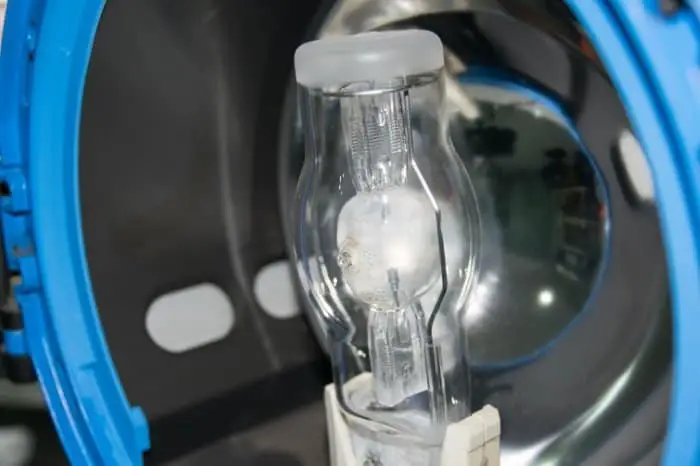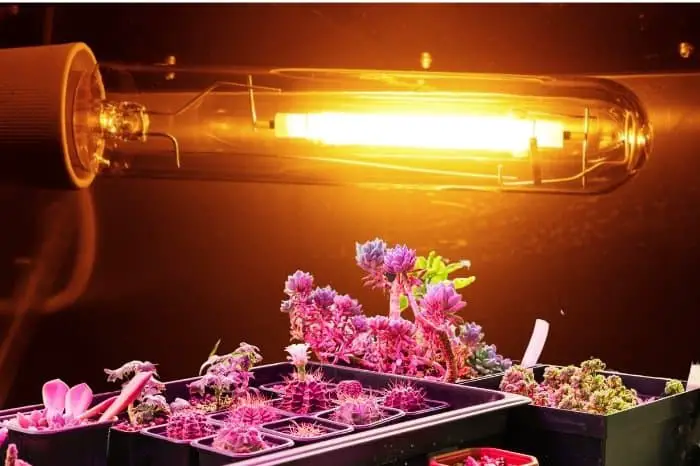Last Updated on January 19, 2023
Both MH (Metal Halide) and HPS (High-Pressure Sodium) are great indoor grow lights for your various plants. However, do you know if MH or HPS is good for flowering? We will answer that in this post.
For general plant growth, both MH and HPS are good for growing. But each of these grow light has specific light characteristics it will offer your plant according to their needs.
The growth stages of plants include vegetative, flowering, and fruiting stage and each of these stages require specific light spectrum. However, in this article, we would like to know if MP or HPS grow light is better for flowering plants. So, continue reading to find out more about this.
MH And HPS Grow Lights
Metal halide (MH) and high power sodium (HPS) are both products of high-intensity discharge (HID). They are quite efficient in terms of indoor growing and can mimic the work done by sunlight. The two grow lights require a ballast to start. Thus, a complete lightning kit is recommended so you don’t miss any important parts especially if you are just starting out.
Let’s take a look at some info on both MH and HPS grow lights.
MH Grow Light
This grow light is a type of HID lamp and they are good for growing plants in their various stages. However, they are mostly or preferably used in the vegetative stage of a plant’s life cycle. They contain a crisp or bluish-white color spectrum, but most MH grow light may lack red wavelengths which are needed for flowering.
Metal halides are built quite closely to mercury vapor lamps. The main difference is that they are composed of additional metal halide compounds in the quartz arc tube and this is to enhance the efficiency and color performance.
Metal halides are rated with a high lumen output of about 100 lm per watt. They are quite long-lasting and can last up to 20,000 hours. They also require a ballast to function.
MH grow lights are known to emit heat. Thus, you should know the appropriate hanging distance to your plants’ canopy. The ideal grow light distance for metal halide plants should be around 8 inches to 25 inches. However, know that this will depend on the type of plant you have and the wattage of your grow light.

HPS Grow Light
HPS grow light is also a type of HID light. Their spectrum comprises red, orange, and yellow wavelengths that enhance roots and flower development. For this reason, they are the best for the flowering phase of a plant. They require a ballast to power on and sustain the electrical arc.
HPS grow lights are less expensive and are great for indoor gardening. However, high-pressure sodium grow light produces heat, therefore the appropriate hanging distance should be considered.
The grow light distance to your plants’ canopy can be around 6 to 34 inches and this will depend on the type of plant you’re growing. It will as well depend on the wattage or strength of your grow light. Also, you should ensure you investigate the plant you have so you can establish the appropriate growing conditions. This is to avoid plant burns from positioning your grow light too close to your plants.
In addition, a ventilation system should be put into considerations to ensure the environment is no too hot for your plants.
iPower 600 Watt HPS MH Digital Dimmable Grow Light System Kits

MH or HPS For Flowering
Metal halide (MH) and high-pressure sodium (HPS) are both high-intensity discharge (HID) grow lights. They are both great for most of your plants’ growth stages and growers usually use them together for a complete grow light system. But which is better for flowering between MH or HPS?
Ideally, HPS is the best for flowering plants. Growers usually begin with a metal halide (around the vegetative phase of a plant) for growing. Then once the plant enters the flowering stage, it is been replaced with high-pressure sodium.
Also, most metal halide grow lights lack the red wavelength that is responsible for the flowering stage. This is why they are not so great for flowering but just vegetative phase. Hence the need to always switch to high-pressure sodium, HPS grows light during the flowering phase.
HPS For Flowering
HPS grow lights are composed of a reddish or orange color spectrum which is associated with the flowering phase of a plant.
The higher lumen or light intensity is also gotten from high-pressure sodium lights. The intensity is usually 25 to 40 percent greater than metal halide bulbs or even the same wattage. This is why HPS is better for flowering because the more light the better for the flowering plant results.

FAQ’s
What is better for flowering HPS or MH grow lights?
HPS lights are great for vegetative growth and flowering.
They're more expensive than MH lights, but they produce much higher amounts of light. They have a lot of heat though, so you'll need a good ventilation system to keep it cool.
MH grow lights are much cheaper than HPS grow lights, but they're not as efficient at producing light. They only produce about half the amount of light that HPS grow lights do, and they don't get very hot. If you have the room, you can grow with MH grow lights. They're perfect for smaller grow spaces.
Can you use both at the same time?
If you would like to save on costs but would like to treat your plants well, a good idea would be a good idea to get one of each.
What I use is a mixture of both. My HPS lights are in a big space, so they're really bright and powerful. But my LED grow lights are in a small space, so they're more efficient. I like using LED grow lights because they produce less heat, which is important for my plants. I also like the idea that you can control them, so I can adjust the brightness of each light to suit my plants. There's also a lot of varieties of LED grow lights out there, but if you're looking for something that will fit in your space, you can find one that does the trick.
What light spectrum is best for flowering?
Light Spectrum is the primary input to the plant. Plants have evolved with certain light spectrums that are best for growth. We are interested in finding out which light spectrum(s) are best for flowering. This may differ depending on the species and the time of year. If you are interested in growing cannabis plants indoors, you will want to use a special light spectrum. A light spectrum is a specific range of wavelengths of light.
As a general rule of thumb, red radiation is the best light for driving photosynthesis at the flowering stage of a plant.
Final Thoughts On MH or HPS For Flowering
Even though HPS is the best for flowering, utilizing both MH and HPS in your indoor garden is a perfect combination for all your plants’ stages. So, if you’re wondering which you should go for, we would say the two.
MH is great for the vegetative stage, while HPS is great for the flowering and fruiting stage and this combination will give you the best growing result.
However, technology has advanced and our regular traditional MH and HPS grow lights is been replaced with LED lights. LED grow light can be used as a standalone light for all your plant growth stage. LED used to cost a lot to purchase, but now, there are various options that can suit your budget.
However, LED grow lights still costs a bit more than the traditional HID, but at a reasonable price. Again, LED lights won’t emit much heat as HD lights do and your investments in the cooling system will be lesser.
All in all, whichever choice you decide to go for, be sure that either HID or LED light will give your plants what they require to grow adequately with the right conditions.

Eunice is an enthusiastic gardener with a passion for growing beautiful flowers. She loves nothing more than spending time in her garden, tending to her plants and enjoying the outdoors. Eunice has been gardening for over 15 years and has developed a unique style of landscaping that is both practical and aesthetically pleasing. She is especially fond of growing roses and enjoys experimenting with different varieties and colors. Eunice takes great pride in her garden and often shares the fruits of her labor with friends and family. In her spare time, she enjoys reading gardening magazines and attending local horticulture events. Eunice is passionate about her hobby and is always eager to share her knowledge and experience with others.
